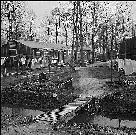 The full caption for this photograph reads: Rohwer Relocation Center, McGehee, Arkansas. View of barracks at Rohwer Relocation Center showing "front yards" and drainage ditch which surrounds each block. |

There is provision for weaving and spinning at Rohwer Relocation Center. This man has grown his own cotton on a little plot by his barrack. Here he is spinning it into thread preparatory to weaving it. |

Many of the evacuees are very skillful woodcravers. This man at Rohwer Relocation Center is at work on a cane. |
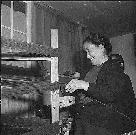
This Issei woman is winding yarn in the weaving room at Rohwer Relocation Center. |
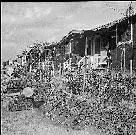
Scene at Rohwer Relocation Center. Alongside the barracks many of the evacuees have small vegetable and flower gardens |
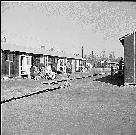
Junior High School students are here changing classes., 11/25/1942 |
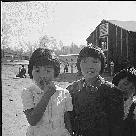
Two young grade school students watch the camera as their pictures are being taken. |
 Ikebana. An example of the Japanese art of arranging plants, flowers and twigs. |
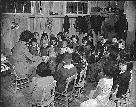
Miss Margaret Morrisy. Story hour in the first grade., 11/22/1942 |
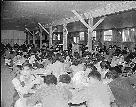
Miss Opal Albright, teacher. Study hall. A converted mess-hall High School. |
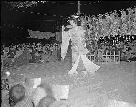
A Japanese folk dancer at an outdoor entertainment., 11/16/1942 |
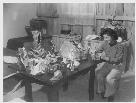 Residents of this center gather strange root and tree formations from the surrounding forests of oak, cypress and gum, and by deft handiwork make many art objects. |
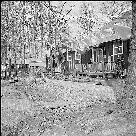
Barrack scene at Rohwer Relocation Center., 12/09/1943 |
 Memorial to the100th Battalion and 442nd Regimental Combat Team |

A monument to those who died at the camp. |
 Memorial |
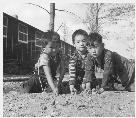 If he's a boy in America he plays marbles, as these lads of Japanese parentage are doing at the Rohwer Relocation Center. 11/17/42
|
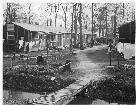 View of barracks at Rohwer Relocation Center showing front yards and drainage ditch which surrounds each block. 12/9/43 |
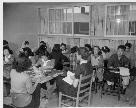 The 11th grade class in American History in the temporary High School. Mrs. B.D. Ramsdell. 11/25/42
|
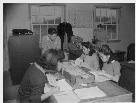 A section of the office staff at the Rohwer Center. 11/25/42 |
 Much of the timber cleared from reclaimed farm lands is used for fuel to heat barracks homes. Cutting and chopping is done by volunteer workers enlisted by block managers, to provide fuel for each individual block. Each capable resident is expected to contribute his share of time to the fuel project.
|
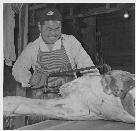 Sam Takeda, a former west coast butcher, cutting a beef quarter in the refrigerator room at the Rohwer Center. With meat rationing strictly adhered to, only experienced butchers are employed in distributing the limited meat supply to mess hall kitchens. They are recruited from center residents (former west coast persons of Japanese ancestry). 3/10/43 |
 A snare drum section of the high school band, in a practice session. Most of the student band members are playing instruments for the first time, and the band is fast becoming a matter of much pride among center residents (former west coast persons of Japanese ancestry). 3/9/43
|
 Ray D. Johnston, left, center director, and Captain John A. Holbrook, chief of an army recruiting team, discuss army with a group of volunteers and Sergeant Isamu Adachi, at the Rohwer Relocation Center. 3/10/43 |
 Special trains are leaving from WRA relocation centers to return people of Japanese ancestry to their homes on the West Coast. On July 26, a train left the Rohwer Relocation Center at McGehee, Arkansas, to take people to Sacramento, Stockton, Lodi, Fresno, and Los Angeles. Pullman accommodations were provided for only the old and sick and for mothers with small babies, others rode in antiquated coaches. Mrs. Cecelia Sutow, U.S. citizen, and her baby are on their way back to Los Angeles while the husband and father is on his way overseas with the U.S. Army. 7/26/43
|
 Special trains are leaving from WRA relocation centers to return people of Japanese ancestry to their homes on the West Coast. On July 26, a train left the Rohwer Relocation Center at McGehee, Arkansas, to take people to Sacramento, Stockton, Lodi, Fresno, and Los Angeles. Pullman accommodations were provided for only the old and sick and for mothers with small babies, others rode in antiquated coaches. Mrs. Hideo Kanow, Mother of four sons in the Army in Italy, all of whom have been wounded, packs to return to Los Angeles on the special train of July 26. 7/26/43 |